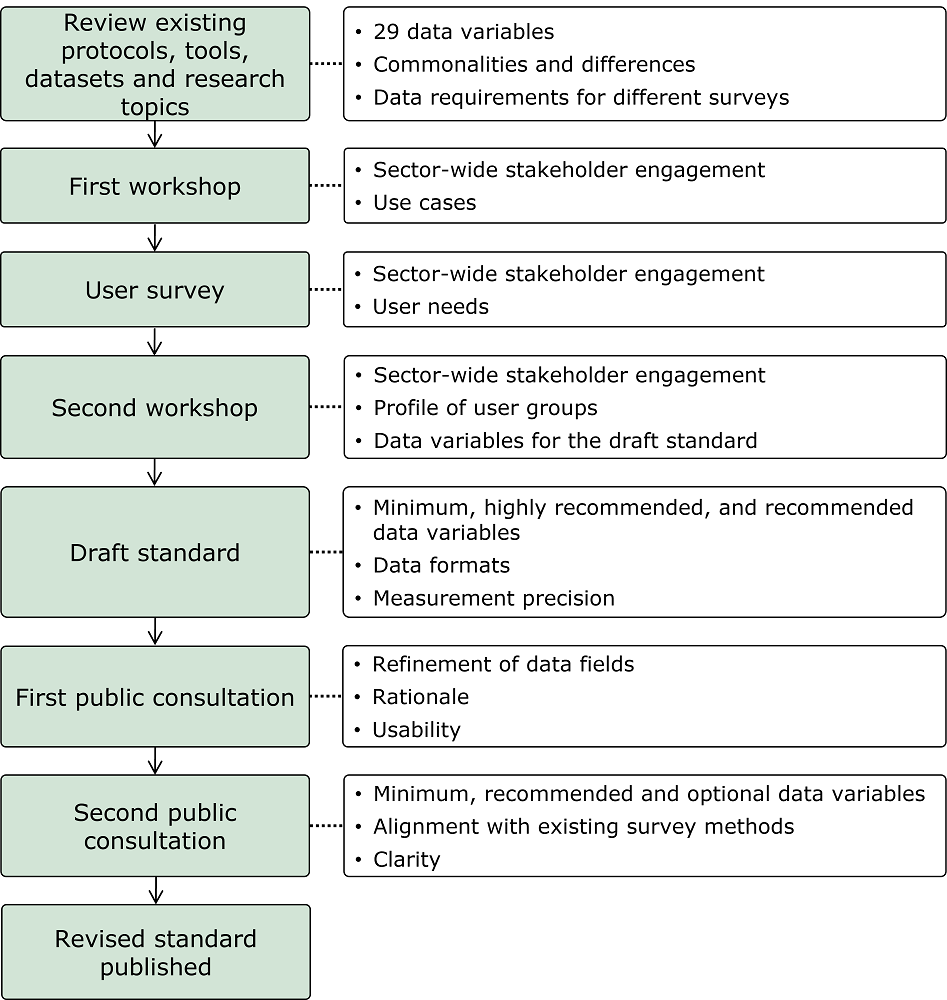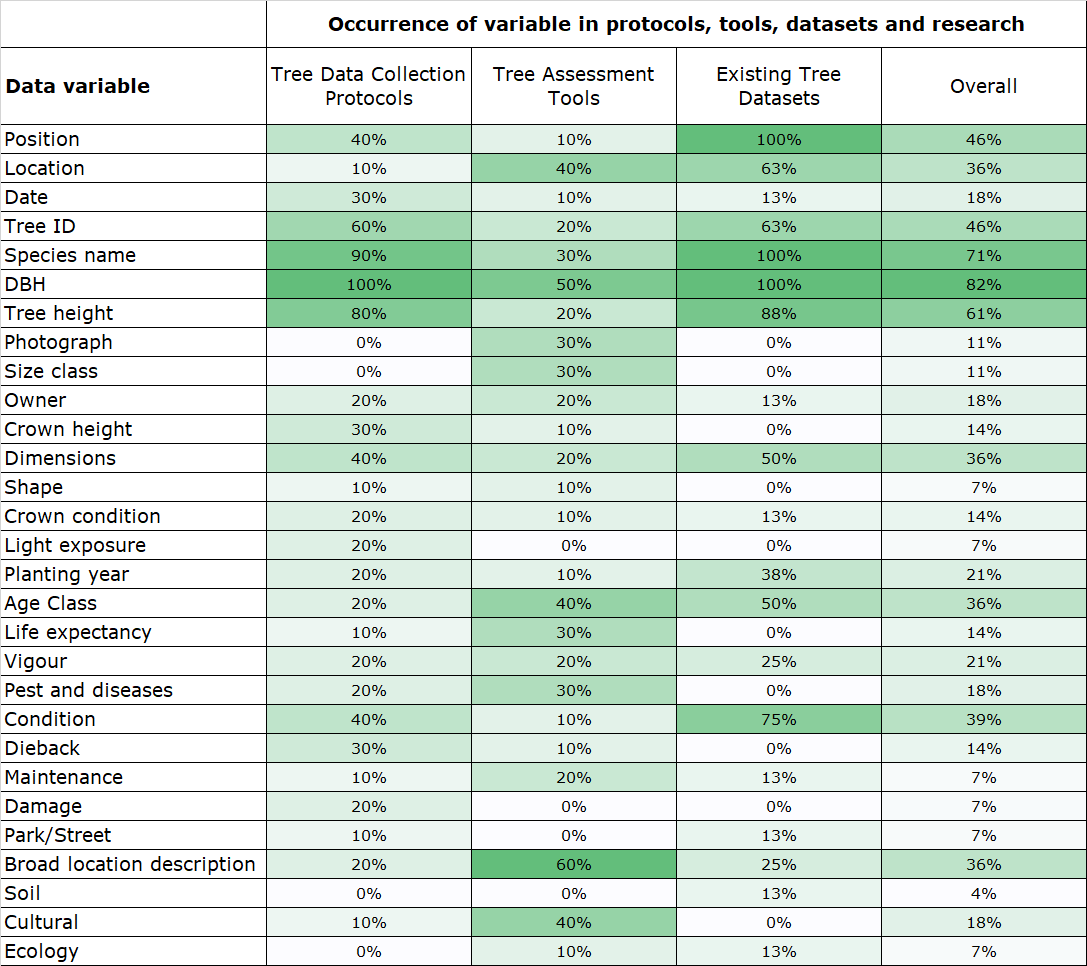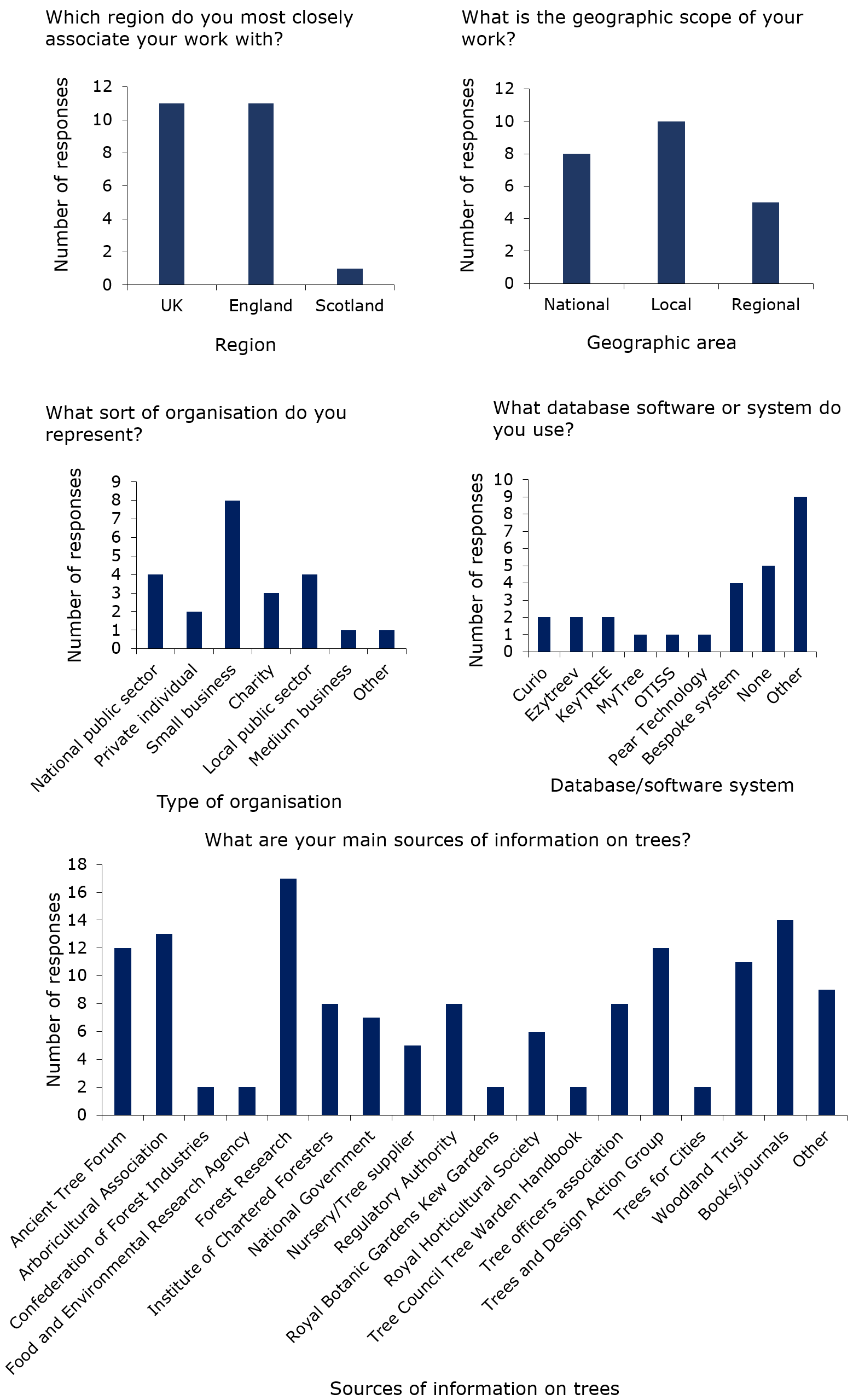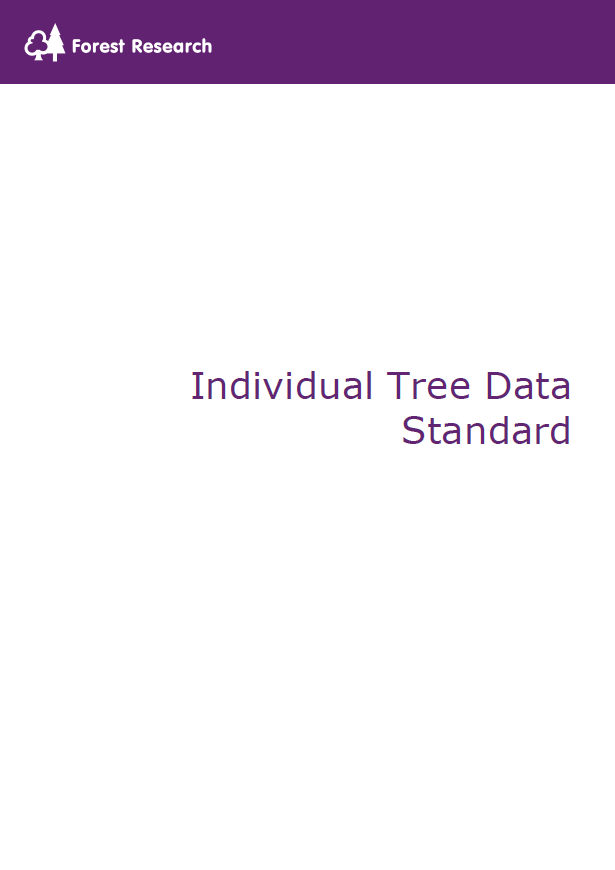Summary
It is estimated that 40 million trees in the UK have been surveyed, and the data stored in local authority databases. Data for just 1.1 million of these trees are included in the UK’s and world’s largest open-access tree database, Treezilla.
Tree surveys are carried out for different purposes and often to different specifications. Many tree data collection protocols and methods overlap in their recommendations but differences between them make it difficult or impossible to compare, combine, or reuse data.
To address these problems in 2019 the COMMUNITREE project partners drafted a new data standard for surveys of individual trees. The steps taken to develop the data standard are described in detail below.
Standardised tree data collection and recording will enable people to easily share their data so that a single dataset can be recycled for many purposes.
The Individual Tree Data Standard is a partnership between Forest Research, the Open University, Treework Environmental Practice, Natural Apptitude, and Innovate UK, and was funded by the Geospatial Commission.
Developing the Individual Tree Data Standard
Overview of Development Process

Workshops
Two workshops and a number of one-to-one consultations formed part of the development of the Individual Tree Data Standard. Workshops were held in May and July 2019 at the Open University in Milton Keynes.
The workshops were attended by representatives from:
- Treework Environmental Practice
- University of West of England
- University College London
- Open University Faculty of Science, Technology, Engineering & Mathematics
- RA Information Systems (Ezytreev)
- Royal Horticultural Society
- Animal and Plant Health Agency
- Plant Health and Seed Inspectorate
- DEFRA
- Tree Plotter
- Woodland Trust
- Field Studies Council
- Tree Council
- Municipal Tree Officers Association (MTOA)
- Haydens Arboricultural Consultants Ltd
- Arbor Cultural
- The Open University
- Forest Research
Research Objectives
- Sector-wide stakeholder engagement
- Development of use cases
- Describing user profiles
- Inform the draft standard
The aims of the first workshop were:
- To bring together a group of individuals representing stakeholder organisations from across the UK urban tree sector
- To consider the roles and contributions of the range of stakeholders that contribute to the collection of data on urban trees
- To establish a set of agreed principles and practices that will form the definitive UK standard for the collection of urban tree data
The aims of the second workshop were:
- To identify and characterise the different potential user groups for an urban tree data standard
- To establish a set or sets of data fields that form the basis of an urban tree data standard
- To discuss how technology might be used to support a data standard
Findings and Recommendations
The first workshop identified the motivations and opportunities associated with establishing a standard, but also raised some barriers and constraints.
The second workshop identified different groups of data collectors and therefore users of a new tree data collection standard, including arboricultural consultancies, development organisations, members of the public/volunteers, policymakers (central and local government), managers of tree populations, academics, third sector organisations, botanic gardens and collections.
Public consultation
The draft standard was put out for two rounds of public consultation between November 2019 and February 2020. The consultation documents are available to download from the Documents’ section on this page.
Research Objectives
The aims of the public consultation were:
- To develop the standard in collaboration with all potential users
- To ensure the standard was usable and fit for purpose
- To enable users to implement the standard with a minimum amount of additional work
- To provide the rationale for each of the data variables chosen
Findings and Recommendations
70 individuals and organisations responded to the first round of consultation, with representation from across the sector and all four nations of the UK.
Key themes emerged from the consultation:
- The standard provides a common language for individual tree description. It defines the format in which the data should be stored.
- The standard needs to provide a clear explanation of each variable and why it has been selected.
- The standard should align with BS5837 where possible.
- Surveyors should be encouraged to measure trees where possible, rather than estimate values.
- Remove the option to use ranges and allow surveyors to estimate variables if it is not possible to measure directly.
- Not every variable needs to be collected in all use cases. 5 variables are included in the ‘minimum’ data that should be collected by all, the remainder are optional with some being ‘highly recommended’.
- The standard is designed for all users, not only for citizen science activities.
The responses were taken into account and several adjustments were made to the draft standard.
The aims of the second round of consultation were:
- To demonstrate how the recommended adjustments had been implemented in the standard
- To give stakeholders a chance to respond to the changes
18 individuals and organisations responded, representing arboricultural consultants, environmental planners, local authority tree officers and managers, botanic gardens, researchers, and non-governmental organisations.
The responses were largely positive, with 70% of the responses requiring no change to the data fields.
Key themes emerged from the consultation and were integrated into the draft standard:
- A flexible approach is required to enable organisations to meet the standard using their existing tools and recording systems
- Data fields require careful description or explanation
- Life stages of the tree to be reviewed
- Structural and biological condition of the tree should be treated separately
- Match the data standard to existing data collection protocols
- Some users would not collect the recommended and highly recommended data in their regular surveys
Each data field in the standard was reviewed in light of the responses to the first and second public consultation. The resulting draft standard will be issued for review by independent experts and the final standard will be published in 2021.
Review of tree data collection protocols, tools, and datasets
Data variables were reviewed in existing data collection protocols, tree assessment tools, and urban tree datasets.
Data collection protocols
- Opal
- BS 5837:2021 Trees in relation to design, demolition and construction. Recommendations.
- i-Tree Eco
- Trees in Towns II
- Forest Mensuration handbook
- Planted Tree Re-Inventory Protocol (PDF 4.8 MB)
- The Need to Standardize At-planting Data (PDF 266 kB)
- Climate Action Reserve
- Green City Partnerships
Tree assessment tools
- RAVEN (PDF 132 kB)
- TEMPO (PDF 630 kB)
- THREATS (PDF 1.3 MB)
- Helliwell
- Treezilla
- Tree Register
- TreeAlert
- Ancient Tree Inventory
- CAVAT – Quick Method
- CAVAT – Full Method
Urban tree datasets
- Belfast
- Birmingham
- Camden
- Havant
- Hayling Island
- High Peak
- Portsmouth
- Test Valley
Research Objectives
The aims of this stage were:
- Collate all data variables in use in existing tree data collection protocols and tools
- Investigate commonalities and differences between protocols and tools
- Examine existing tree datasets to find the variables that were recorded
Findings and Recommendations
The 29 data fields identified in the protocols, tools and datasets, formed the basis for the first draft of the data standard. More details can be found in Review Summary spreadsheet in the Documents section, below.

Tree data collection user survey
The questionnaire sent out in the user survey is available in the Documents section, below. The survey was open to large and small businesses, national public sector organisations, local or regional public sector organisations, charities, non-governmental organisations, and individuals.
Research Objectives
The survey posed questions designed to gather information on:
- Reasons for tree data collection
- Data collection methods
- Commonly collected variables
Findings and Recommendations
There were 23 responses to the survey. The response to each question is summarised below.

Latest Update
The Individual Tree Data Standard is now available in the Downloads section, below.
On behalf of Forest Research the Botanical Society of Britain and Ireland (BSBI) are building a definitive list of UK tree species and their accepted taxonomic names. When completed the list will be published here, free for all to download and use, to facilitate adoption of the Standard.
Forest Research has built an online survey form to accompany the Standard. The Individual Tree Data Survey has been designed to make it easy to collect tree data that conforms to the standard.
General Content
Citation
An appropriate citation for this work is:
Handley, P., Walker, H., Ansine, J., Baden, R., Craig, I., Dewhurst-Richman, N., Doick, K. J., Fay, L., Mackie, E., Parratt, M., Perez-Sierra, A., Sparrow, K., Wheeler, P. (2021). Individual Tree Data Standard. Forest Research, Farnham. ISBN 978-1-83915-015-9.
Contact
If you have questions, comments, or suggestions relating to the Standard, please email itds@forestresearch.gov.uk.
Downloads

Individual Tree Data Standard
Standard for collection, recording, and sharing of data about individual trees
First Public Consultation Document
Second Public Consultation Document
Review of tools, protocols, and datasets Summary Spreadsheet
Funding & Partners
-
 Geospatial Commission (Ref: 29761)
Geospatial Commission (Ref: 29761) -
 Forestry Commission
Forestry Commission -
 The Open University
The Open University -
 Treework Environmental Practice
Treework Environmental Practice
